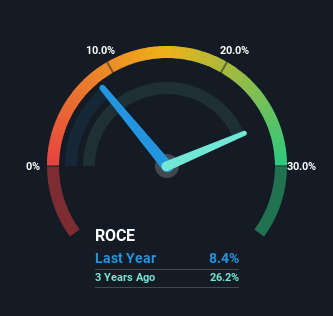- China
- /
- Electrical
- /
- SZSE:300763
The Returns On Capital At Ginlong Technologies (SZSE:300763) Don't Inspire Confidence

To find a multi-bagger stock, what are the underlying trends we should look for in a business? Firstly, we'd want to identify a growing return on capital employed (ROCE) and then alongside that, an ever-increasing base of capital employed. This shows us that it's a compounding machine, able to continually reinvest its earnings back into the business and generate higher returns. In light of that, when we looked at Ginlong Technologies (SZSE:300763) and its ROCE trend, we weren't exactly thrilled.
Return On Capital Employed (ROCE): What Is It?
For those that aren't sure what ROCE is, it measures the amount of pre-tax profits a company can generate from the capital employed in its business. The formula for this calculation on Ginlong Technologies is:
Return on Capital Employed = Earnings Before Interest and Tax (EBIT) ÷ (Total Assets - Current Liabilities)
0.084 = CN¥1.3b ÷ (CN¥21b - CN¥5.7b) (Based on the trailing twelve months to September 2023).
Therefore, Ginlong Technologies has an ROCE of 8.4%. In absolute terms, that's a low return, but it's much better than the Electrical industry average of 6.3%.
Check out our latest analysis for Ginlong Technologies

Above you can see how the current ROCE for Ginlong Technologies compares to its prior returns on capital, but there's only so much you can tell from the past. If you're interested, you can view the analysts predictions in our free analyst report for Ginlong Technologies .
What Can We Tell From Ginlong Technologies' ROCE Trend?
The trend of ROCE doesn't look fantastic because it's fallen from 42% five years ago, while the business's capital employed increased by 4,571%. However, some of the increase in capital employed could be attributed to the recent capital raising that's been completed prior to their latest reporting period, so keep that in mind when looking at the ROCE decrease. It's unlikely that all of the funds raised have been put to work yet, so as a consequence Ginlong Technologies might not have received a full period of earnings contribution from it.
On a related note, Ginlong Technologies has decreased its current liabilities to 28% of total assets. That could partly explain why the ROCE has dropped. What's more, this can reduce some aspects of risk to the business because now the company's suppliers or short-term creditors are funding less of its operations. Some would claim this reduces the business' efficiency at generating ROCE since it is now funding more of the operations with its own money.
The Bottom Line
Even though returns on capital have fallen in the short term, we find it promising that revenue and capital employed have both increased for Ginlong Technologies. These trends don't appear to have influenced returns though, because the total return from the stock has been mostly flat over the last three years. So we think it'd be worthwhile to look further into this stock given the trends look encouraging.
On a final note, we found 3 warning signs for Ginlong Technologies (2 are a bit concerning) you should be aware of.
While Ginlong Technologies isn't earning the highest return, check out this free list of companies that are earning high returns on equity with solid balance sheets.
New: Manage All Your Stock Portfolios in One Place
We've created the ultimate portfolio companion for stock investors, and it's free.
• Connect an unlimited number of Portfolios and see your total in one currency
• Be alerted to new Warning Signs or Risks via email or mobile
• Track the Fair Value of your stocks
Have feedback on this article? Concerned about the content? Get in touch with us directly. Alternatively, email editorial-team (at) simplywallst.com.
This article by Simply Wall St is general in nature. We provide commentary based on historical data and analyst forecasts only using an unbiased methodology and our articles are not intended to be financial advice. It does not constitute a recommendation to buy or sell any stock, and does not take account of your objectives, or your financial situation. We aim to bring you long-term focused analysis driven by fundamental data. Note that our analysis may not factor in the latest price-sensitive company announcements or qualitative material. Simply Wall St has no position in any stocks mentioned.
About SZSE:300763
Ginlong Technologies
Engages in the research, development, production, service, and sale of string inverters worldwide.
Solid track record and fair value.
Similar Companies
Market Insights
Community Narratives



